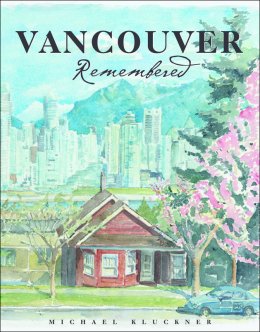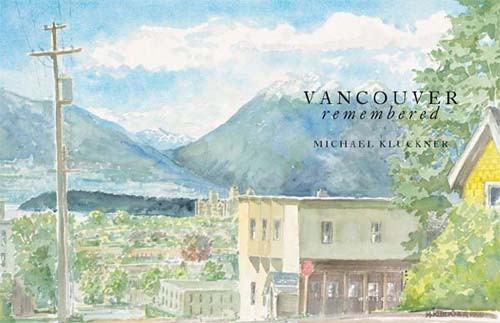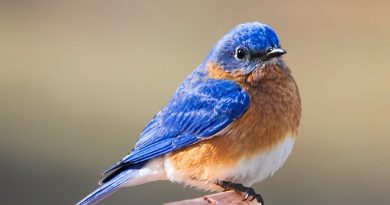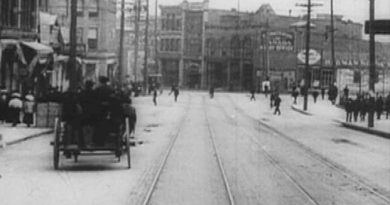Vancouver Remembered
There’s an instructive and funny little sidebar buried in Michael Kluckner’s newest book, Vancouver Remembered. In 1985 he was commissioned to paint an image of Vancouver for a centennial poster series, and tried in vain to find a streetscape that combined old and new Vancouver. Finally, he invented a view, looking west from the corner of Frances Street and Victoria Drive. In the distant background were the towering office buildings of modern downtown Vancouver. There was a corner store on the block, and Kluckner painted that, but changed its name. There was a turreted house at the end of the block, and he kept that in his painting . . . but instead of the row of three-storey walkups that lined the street he painted a variety of houses, a “representative sampling” from other parts of Grandview.
“I was intrigued,” he writes, “by the number of people at poster signings and public events that Centennial spring who said they had once shopped at the store or lived in one of the houses.”
Books like Vancouver Remembered help to keep our memories tidy and correct, and alive. This one, Michael tells us, completes a trilogy on the physical evolution of Vancouver, and brings his own very personal overview of the city’s past almost up to the present day. (The two preceding volumes were 1984’s Vancouver The Way it Was and 1990’s Vanishing Vancouver.)
“Vancouver’s long decline and slow rebirth,” he writes, “are the main themes of this book.”
You can see more detail on Michael’s own site.

The specific period covered in this book, his 15th, is the time between the end of the Second World War and Expo 86. “Once upon a time,” the publisher’s blurb tells us, “in the near-forgotten era before Expo ’86, Vancouver, like a sleeping beauty, needed an awakening and a makeover. The downtown had a scattering of new office buildings, interspersed with aging hotels, shops and parking lots. Derelict industrial blocks lined the waterfront . . .” In a recent public appearance at the main library to talk about the book, Michael described it as an “elegy” for Vancouver before Expo. An elegy expresses sorrow for something vanished. It’s a word that seems to be at odds with the book’s own blurb!
For the first 27 years of my own life, I spent roughly two years in Burnaby, and two more in Vancouver . . . far fewer than Michael, who was born in Vancouver and grew up here. That gives him a feel for the city that-even 30 years after I began to write about its past-I can’t begin to approach. His preface is rich with personal reminiscences of growing up in Kerrisdale in a $12,000, 20-year-old house, of playing road hockey on his quiet street, of walking unaccompanied to school, going to brand-new Oakridge Shopping Centre with his mother, visiting his father’s office in the BC Electric building at Carrall and Hastings, attending the little Anglican church on West 57th “near the tracks.” He comes by his knowledge of and affection for the city honestly. I was fortunate to have him as one of the writers in my Greater Vancouver Book in 1997, to which he contributed many fine articles on the city’s neighborhoods.
There are two main sections in the new book. The first is Commercial Vancouver, with chapters on Gastown & the Downtown Eastside; Chinatown; Victory Square; Downtown; and Yaletown & False Creek. The second, Residential Vancouver, has sections on Strathcona; the West End & Stanley Park; Fairview, Mount Pleasant & False Creek; Kitsilano & Jericho; the West Side, and the East Side.
![50th birthday topographical study; contribution to the Artropolis 2001 Self-Portrait Exhibition
[Photo: www.michaelkluckner.com]](https://vancouverhistory.ca/wp-content/uploads/2021/01/kluckner.jpg)
[Photo: www.michaelkluckner.com]
You get a lot in a Michael Kluckner book: watercolor paintings, photographs, hand-rendered maps, vintage advertisements, personal reminiscences, anecdotes and informed architectural detail. His paintings are charming, created, incidentally, out of a comically tiny paintbox-made by Winsor & Newton of Sheffield, England-that he showed his audience at the library. It’s the size of a cellphone, but he gets big effects from it.
The book is attractively laid out. It’s a really handsome work and will make a fine Christmas present. His hand-painted maps, with buildings and railways and rivers and streets and the like nicely rendered and labelled, are terrific. There’s a small map drawing, for example, of the “Upper Kits Industrial Area 1910-60s” on Page 175 that is a joy to look at. The annotations add to its funky charm: “McGavin’s Bakery occupied the half-block west of Arbutus; a 10-foot hand holding a loaf of bread rose above the building’s northeast corner”. And on the map there’s a tiny representation of that big bakery building. If he made a wall map of today’s city in the same style I think he’d sell thousands!
There are pleasant nuggets of information all through the book. We learn that nearly a century ago Lost Lagoon was the target of a “City Beautiful” plan that would have seen the lagoon filled in to provide space for a sports field or a museum or stadium. Michael quotes a Park Board engineer of the time who said, “Fortunately, they never got beyond the plan stage. The design might have been suitable for a Peace Palace or a European Capitol, but would have resulted in substituting for the present beautiful natural lagoon a purely artificial treatment at a very high cost.” Michael comments, “Once again, lack of money saved Vancouver from the visionaries.”
Curiously, the major problem in the book is the facts. Not that they’re wrong, far from it; it’s just that there are so darned many of them—lots and lots and lots and lots and lots and lots of them. In its 233 pages it’s a rare paragraph that doesn’t contain a half-dozen facts or more.
Here’s an example, from Page 197: “The west side, with the exception of Marpole and the Kerrisdale village, is the city’s single-family heartland, a bastion defended vigorously against incursions by apartment developers, lot subdividers and basement-suite barons. Its geographic base is the CPR’s 1884 land grant south of the original city boundary of 16th Avenue; its historic base stems from a distrust of the freewheeling land-use and management practices of the old Municipality of South Vancouver, which proved incapable of systematic tax collection, street paving, tree planting and park creation. Calling themselves the Municipality of Point Grey, the west-siders separated in 1908, establishing a more orderly fiefdom west of Cambie Street, building the Point Grey Municipal Hall in Kerrisdale at 42nd and West Boulevard (the community centre site) and enforcing strict zoning rules, the most noticeable of which is the uniform house setback from the streets.”
Read by itself that might seem okay. But read as I did for this review, in a couple of long sessions, the avalanche of facts in the book occasionally works against opportunities for eloquence and the affection Michael has for the city. Inventories are seldom poetic.
But there are so many riches here that we can safely add this to the list of genuinely valuable books on Vancouver. “Due to the amount of Vancouveriana,” Michael writes, “it has become quite a challenge to create a book that presents relevant new material . . .” Not to worry, Mr. Kluckner, you’ve done it.
(This article originally appeared in The Vancouver Sun on November 25, 2006.)



![Vancouver Coat of Arms [Image: Wikipedia]](https://vancouverhistory.ca/wp-content/uploads/2021/01/1024px-Coat_of_arms_of_Vancouver.svg_-390x205.png)
